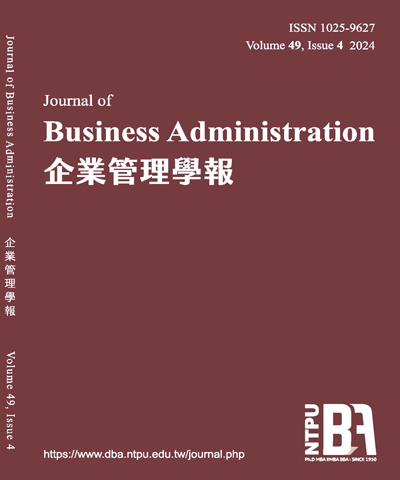
企業管理學報/Journal of Business Administration
國立臺北大學企業管理學系,正常發行
選擇卷期
- 期刊
本研究以角色理論觀點提出高科技產業員工離職傾向之整合模型,樣本為台灣高科技產業非主管職員工,採問卷調查法搜集資料 (共發出300 份,有效樣本240 份),以路徑分析方法進行假設驗證。研究結果顯示:工作敬業心和工作—家庭衝突共同預測離職傾向的效果最好;對離職傾向的個別影響效果以工作敬業心最大,工作—家庭衝突次之,組織公民行為最小。在理論上,本研究提出預測離職傾向的模型,釐清不同類型角色變項對離職傾向的影響程度;在方法上,本研究有別於過去之個別探討方式,將影響離職傾向的角色因素同時納入模型,透過降低統計誤差提出更嚴謹之驗證結果。在實務上,本研究提出整合性指標及其重要性順序,協助高科技產業更有效率掌握員工離職議題。
- 期刊
人力銀行是求職者與雇主間一個很受歡迎的管道,有關著個人工作與社會的穩定。本研究以馬斯洛需求理論為基礎發展人力銀行使用者之需求題項,試圖找出使用者需求與使用者忠誠度之關聯性,並加入使用者滿意度變項深入研究。以立意抽樣方式回收有效問卷441 份。本研究結果顯示,使用者需求與忠誠度證實具有部份正向顯著影響。另外,以滿意度作為干擾變項,結果顯示滿意度與忠誠度有正向顯著的關係,而滿意度同時對使用者需求與忠誠度產生交互作用,扮演部份干擾角色。本研究根據結果,提出對學術與實務的建議,供人力銀行業者應用於網站服務的經營方向與策略的制定,而對於求職者則能提供更符合真實需求之服務與產品,進而協助其就業。
- 期刊
Smart device applications (SDAs) play an important role in today’s society and economy. However, because new SDAs are continually being developed, identifying the factors that motivate individuals to download SDAs is critical. This study applied the decomposed theory of planned behavior to examine how the antecedents of attitude, subjective norms, and perceived behavior control beliefs explain and predict consumers’ intention of adopting a particular SDA. In total, 320 valid questionnaires were collected through Google Docs and were reviewed using structural equation modeling. We confirmed the stated hypothesis that attitude, subjective norms, and perceived behavior control of SDA adoption affected consumers’ intention to download applications. The results also revealed that compatibility and self-efficacy do not positively influence consumers’ intention to adopt SDAs. Finally, we uncovered that network externalities indirectly impact individuals’ intentions toward the adoption of SDAs.
- 期刊
The purpose of this paper is to examine the relationship between brand orientation, brand value and relationship value. This inquiry is motivated by the increase use of relationship marketing particularly in the airline industry in Taiwan, in which there is competition for better relationship quality between airliners and customers, given the recently increasing number of companies using brand-oriented marketing strategies. In our study, brand value is divided into two intermediate variables for our research framework: functional value and emotional value. We also separate relationship value into relationship benefits and relationship costs. In addition, we discuss whether global brand attitude, word-of-mouth, and brand heuristic increase the perceived customer brand value. In conclusion, global brand attitude clearly influences functional value, and functional value clearly influences relationship benefits and relationship costs.

